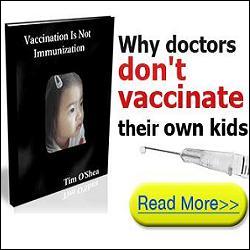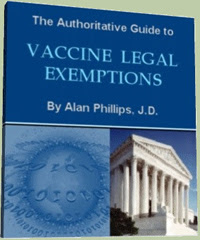Sanofi Pasteur, the world’s largest manufacturer of vaccines, is currently facing serious troubles, as countries around the world are scrutinizing Sanofi’s products and practices. Recently, they have reported a massive third quarter decline of $1.8 billion in vaccine sales. This news follows a previous second quarter report described by one investment website as “pretty ugly reading,” with decreased sales in all divisions, as well as a 28 percent loss in operating income. [1]
The large decline in operating income and vaccine profits provides an easy indicator that governments and individuals worldwide are becoming suspicious of pharmaceutical companies. However, the news that should be most concerning to parents is the warning letter the FDA has given to Sanofi. The FDA recently cited Sanofi for dozens of concerns about their vaccine production, including the presence of contamination and mold.
The FDA vaccine information sheets given to parents before or after their child is vaccinated claim overall that a vaccine is “safe.” You won’t find any of the following disturbing, factual examples of widespread vaccine contamination and big pharma bribery on the piece of paper your doctor gives you.
Unfortunately, you probably won’t learn about contamination and bribery in the world of vaccines from your child’s healthcare provider or mainstream media sources. Read on to learn why these must-know problems associated with vaccine manufacturing and marketing should be the “shot news” heard ’round the world.
The FDA Cites Sanofi for Mold and Contamination Problems in Canada
In 2012, the FDA cited a Sanofi vaccine manufacturing plant in Canada for numerous incidences of contamination. In a letter to its shareholders, the pharmaceutical company dismissed the contamination as an “anomaly,” in an attempt to explain their staggering decline in vaccine profits. The contamination caused a shortage of whooping cough vaccines which are distributed in the United States. [2]
Concerns cited by FDA investigators in their warning letter to Sanofi officials included the following, just a few of the 58 citations:
“You failed to establish the accuracy, sensitivity, specificity, and reproducibility of test methods employed by your firm.”
“You failed to assure an adequate system for monitoring environmental conditions.”
“You failed to assure an adequate system for cleaning and disinfecting aseptic processing areas and equipment.”
“You failed to maintain buildings in a good state of repair.”
“You failed to validate the effectiveness of disinfectants used in Building (b)(4), where live Poliovirus is grown, under actual conditions of use.”
“Your investigations into the failure of a batch or any of its components are inadequate.” [3]
A spokesperson from Sanofi claimed that the warning letter from the FDA was unrelated to the recent contamination which caused a monumental loss in profit for the pharmaceutical company. However, many of the 24 comments made by the FDA in the warning letter were indeed related to the presence of mold and contamination at the plant, which had been affected by flooding.
This investigation began in August 2010 during a routine plant inspection. [4]
CEO Chris Viehbacher claimed that the problem had been resolved.
 In contrast to Viehbacher’s optimistic words, the FDA letter likely contributed to the shutdown of some company operations, an action which is expected to cause a shortage of tuberculosis vaccines.
In contrast to Viehbacher’s optimistic words, the FDA letter likely contributed to the shutdown of some company operations, an action which is expected to cause a shortage of tuberculosis vaccines.
Do you think the contamination in the Canada plant was an isolated event, affecting only whooping cough vaccines sent to the US? Sadly, no. The story of toxic contamination at Sanofi facilities spans across countries around the world.
Concerns about Sanofi Vaccines in Australia
If the million-dollar drop in profits, as well as the plant shutdown, was truly unrelated to the FDA’s warning letter to Sanofi, perhaps company shortfalls were caused by Australian regulators, who contacted the big pharma company with concerns about sterility from a tuberculosis vaccine, which will result in another vaccine shortage.
How did Sanofi respond to those very serious, tragic concerns? Four batches of the tuberculosis vaccine were recalled, and production was halted at a Canadian plant. Sanofi official claimed in an email to have “full confidence in the products released from its facilities.” Olivier Charmeil, the executive vice-president of the company’s vaccine division, also stated, “I have full confidence in our products in the market.”
The tuberculosis vaccine administered in Australia wasn’t the only Sanofi vaccination to cause problems there. In 2010, the Australian government encouraged parents to vaccinate their children against the flu. However, they later instituted a temporary ban on childhood flu vaccines. Why? Because, shortly after receiving the vaccination, children developed seizures, began vomiting, and developed high fevers. [5]
Four Children Die in Japan After Receiving Sanofi and Pfizer Vaccines
In 2011, as reported by Natural News and Reuters, four children in Japan died following multiple jabs in one visit with the vaccines made by Sanofi and Pfizer. Three of the children died within a day of receiving their vaccinations. The health ministry suspended use of vaccines from those companies. [6, 7]
Just days later, Sanofi recalled 13 lots of their haemophilus influenza type b vaccine (HiB) after discovering the syringes used to reconstitute the vaccine with the diluent were contaminated. [8] Despite this sickening discovery, the Japanese investigative government panel later released Sanofi from any wrongdoing, asserting there was nothing wrong with the vaccines and the deaths were unrelated. [9]
Chinese Investigations Focus on Sanofi
Sanofi’s problems are not related solely to production issues. Marketing practices have also caused immense problems for the vaccine manufacturer.
Following a lengthy, ongoing investigation, Chinese officials have charged Sanofi with bribery. Sanofi claims that payments of $280,000 to doctors were actually research grants. If Sanofi is found guilty of those allegations, they may be blacklisted from the emerging and profitable Chinese market or forced to drop their prices on products they sell there. [10]
Sanofi claims their company “remains confident” about their Chinese operations.
Another source states that, in 2007, Sanofi representatives bribed 503 Chinese doctors with payments. [11]
Can you predict Sanofi’s response? “At this time it would be premature to comment on events that may have occurred in 2007,” a company spokesperson stated.
During the recent government investigations in China regarding unethical practices by Big Pharma companies, eleven Chinese officials visited one of Sanofi’s regional offices on July 29, 2013, but the company CEO claimed, “We are not really aware of the purpose of the visit.” [12, 13]
Additional Contamination Concerns about Sanofi in France
 Even in France, Sanofi’s home base, the FDA is citing the vaccine giant for contamination problems. In 2010, The FDA cited a Sanofi vaccine manufacturing plant in France for failing to “follow procedures designed to prevent microbial contamination.” Concerns raised by FDA investigators revolved around typhoid vaccines, rabies vaccines, and haemophilus vaccines, including why some vaccines did not fall within the specification ranges during testing or why some batches failed to meet specifications. [14, 15]
Even in France, Sanofi’s home base, the FDA is citing the vaccine giant for contamination problems. In 2010, The FDA cited a Sanofi vaccine manufacturing plant in France for failing to “follow procedures designed to prevent microbial contamination.” Concerns raised by FDA investigators revolved around typhoid vaccines, rabies vaccines, and haemophilus vaccines, including why some vaccines did not fall within the specification ranges during testing or why some batches failed to meet specifications. [14, 15]
Perhaps the FDA gave its most serious warning to Sanofi — or the warning Sanofi is most likely to heed — when they said they would share this information with other governmental agencies “so that they may take this information into account when considering the award of contracts.”
Conclusion
Pharmaceutical companies like Sanofi Pasteur have demonstrated a lack of commitment to following the proper procedures for manufacturing vaccines (which are already chemically laden with dozens of dangerous substances) in a manner free of contamination.
Their sales representatives market these products in existing and emerging markets in unethical ways. If these products are really so amazing and safe, why do drug representatives have to bribe doctors to prescribe them to their patients?
When billions of dollars are at stake in profit margins, can you trust pharmaceutical companies to keep your child’s safety and wellness first in their business plan?
Governments from many countries are investigating the production and marketing of vaccines, even banning some of them for distribution among their citizens. Even the governments of Australia and Japan, who instituted temporary bans on vaccines, didn’t stop the the use of these dangerous vaccinations in time to save children from injury and death.
However, you can’t wait for your government ban dangerous vaccines. You must research for yourself what harmful substances are being injected into your child.
In order to protect your child, I urge you to read two documents. The first one is the FDA warning letter I referenced earlier in this article, a government document you can access here. Before you choose to vaccinate your child, you must make yourself aware of the dozens of ways vaccines are contaminated during production. Remember, the whooping cough vaccine commonly administered to children in the US was produced at one of the plants cited in the warning letter. The information in the letter is disturbing but, as a parent, you must educate yourself before you vaccinate your child.
 Next, I urge you to learn more about the dangerous ingredients in vaccines. In addition to having issues with contamination and mold, vaccines contain other substances most parents would not want to knowingly inject into their child: fetal calf serum, polysorbates, mercury, sodium chloride, formaldehyde, and many other substances you would not allow your child to eat, lick, or even touch. To protect your child from being injected with these toxic ingredients, download our free resources now.
Next, I urge you to learn more about the dangerous ingredients in vaccines. In addition to having issues with contamination and mold, vaccines contain other substances most parents would not want to knowingly inject into their child: fetal calf serum, polysorbates, mercury, sodium chloride, formaldehyde, and many other substances you would not allow your child to eat, lick, or even touch. To protect your child from being injected with these toxic ingredients, download our free resources now.
References
3. http://www.fda.gov/ICECI/EnforcementActions/WarningLetters/2012/ucm312929.htm
5. http://www.naturalnews.com/029586_Australia_vaccines.html
6. http://www.naturalnews.com/031616_vaccines_Japan.html
7. http://www.reuters.com/article/2011/03/07/us-japan-vaccine-idUSTRE7260LY20110307
11. http://www.fiercepharma.com/story/sanofi-faces-bribery-allegations-china-whistleblower/2013-08-08
12. http://www.fiercepharma.com/story/tension-rises-china-officials-fine-jj-visit-sanofi/2013-08-01
13. http://www.bloomberg.com/news/2013-08-01/sanofi-cuts-forecast-as-earnings-miss-on-generic-woes.html
14. http://www.reuters.com/article/2010/07/29/us-sanofi-plant-idUSTRE66S62D20100729
This article first appeared at VacTruth



Be the first to comment on "Dangerous Contamination in Vaccines Causes Sinking Profits for Big Pharma"